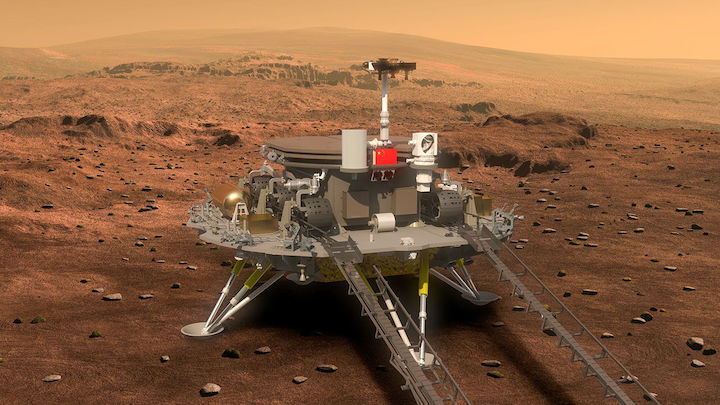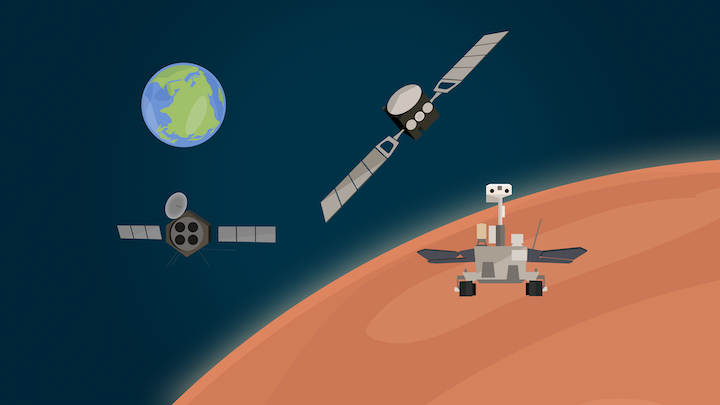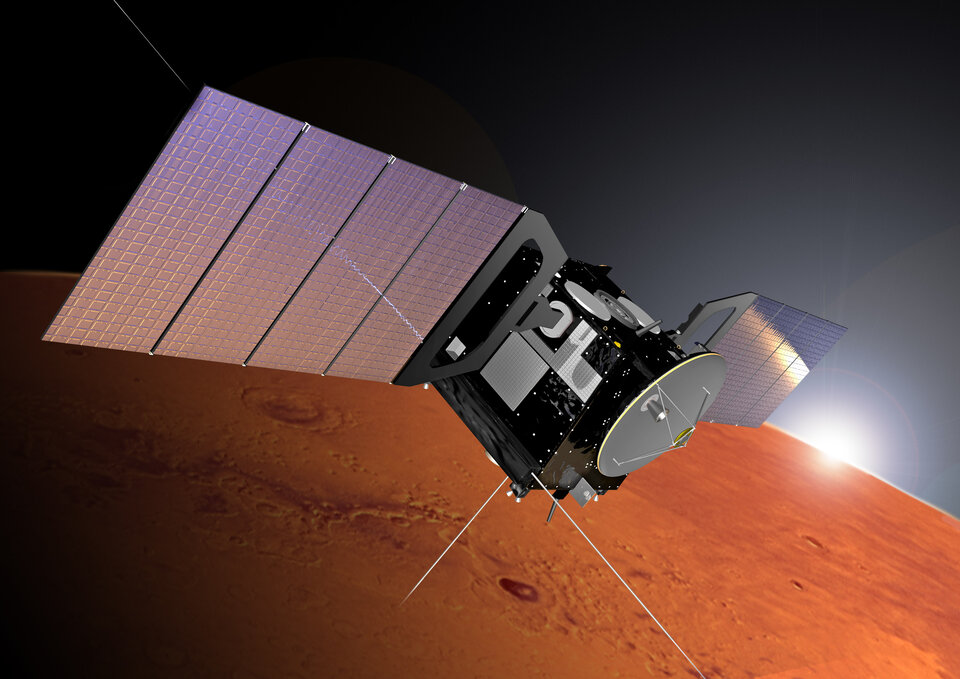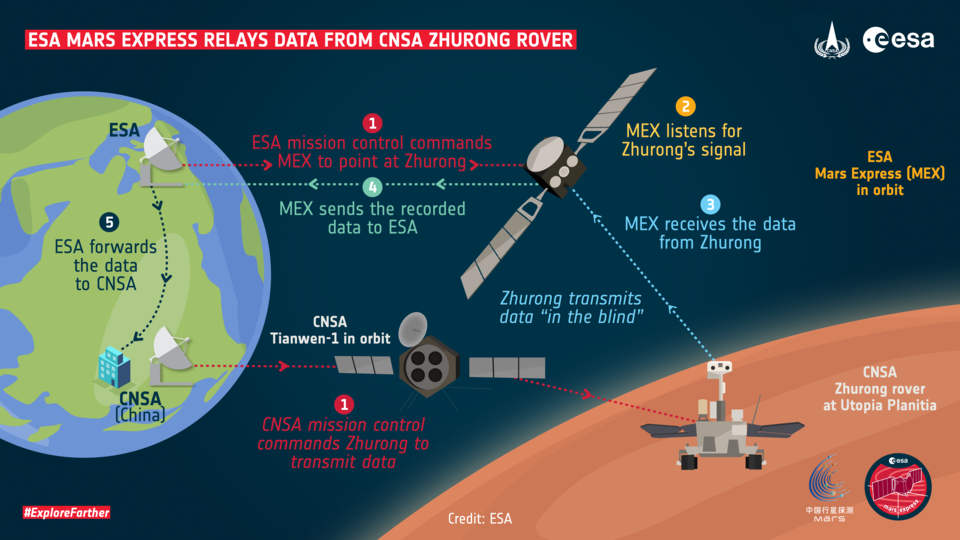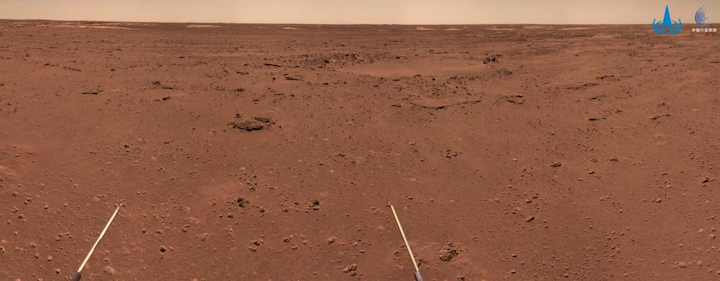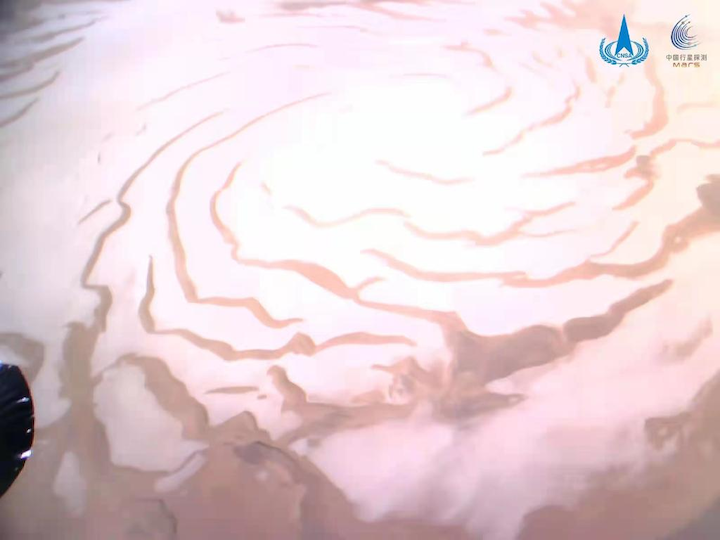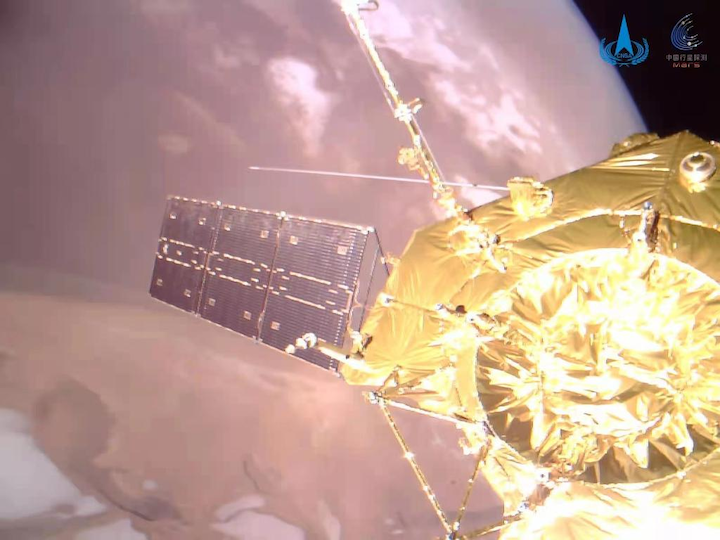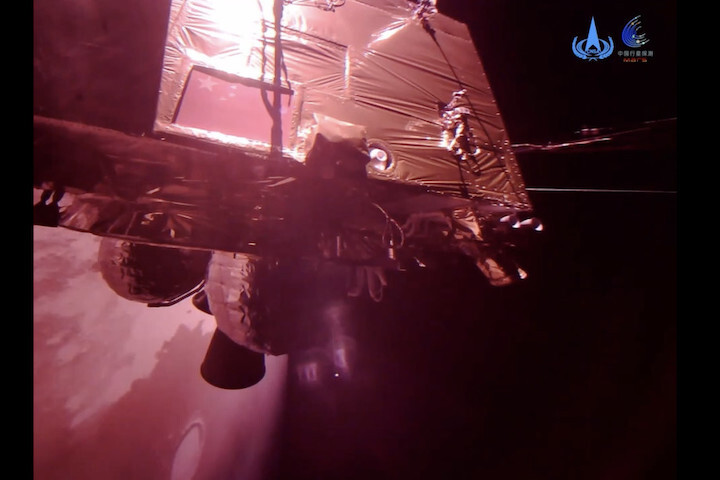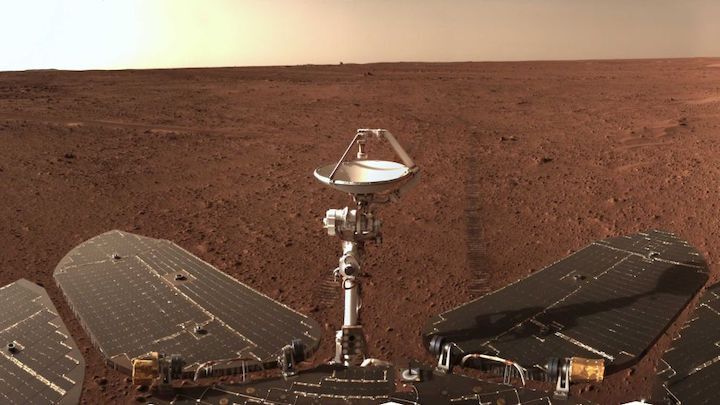China’s first Mars rover reveals how weather and ancient water changed the surface of the largest impact basin on Mars.
A new study based on data from Zhurong’s first 60 sols (roughly 62 Earth days) on the planet reveals how weather and interaction with water altered the rocks around Zhurong's landing site over millions of years.
In the study, a team of researchers led by Liang Ding of the Harbin Institute of Technology in Northeast China, used images from the rover’s Navigation and Topography Cameras (NaTeCam) to look at the structure of the rocks. In many of the studied rocks, the researchers found grooves and etchings from particles carried by wind, but also flakes which appear to be evidence of interactions with water or brines.
"The rock textures observed at the site thus far may indicate both the presence of physical weathering – for example, impact sputtering, wind erosion and potential freeze–thaw weathering – and aqueous interactions involving salt and brine," the authors said in the paper, adding that the site offers opportunities for follow-up investigations.
"These rock and soil targets provide excellent opportunities to peek into the aqueous history and climate evolution of the northern lowlands, and shed light on the habitability evolution of Mars."
Kirsten Siebach, an assistant professor at the Rice University Department of Earth, Environmental, and Planetary Sciences, agrees with the assessment by the Chinese team.
"It looks like there's surface evidence for something like a contraction-expansion process, which can be from brine or a freeze/thaw effect or really significant temperature changes," she told Space.com. "That causes the rocks to kind of flake apart. This is consistent with what we've seen at other landing sites on Mars where the rocks are exposed differently than on Earth."
Chemistry data would help provide more information on what has been going on in the area. Zhurong has a Laser Induced Breakdown Spectroscopy (LIBS) instrument which could fire its laser to create a tiny amount of plasma from the target and analyze its composition. The new paper does not make use of any LIBS data, nor states if it was collected from the rock specimens.
Siebach also underlines the value of having images and data from a new landing site on Mars.
"By having 9 to 10 landing sites across the surface of Mars, we're starting to get a better sense for what processes are relatively or seem to be global," Siebach said.
Siebach notes that the paper contains a lot of valuable information on the physics of the soil and how the ground reacts to the rover driving over it and its landing equipment. "This is actually really important if you want to land there with humans."
China is planning a Mars sample return mission, potentially launching in 2028, but has not yet released information on candidate landing sites.
Zhurong has already completed its primary mission of 90 sols. But the rover is continuing its way to the south of its landing site, collecting data as it goes.
Zhurong's 10-month journey is visible from Mars orbit.
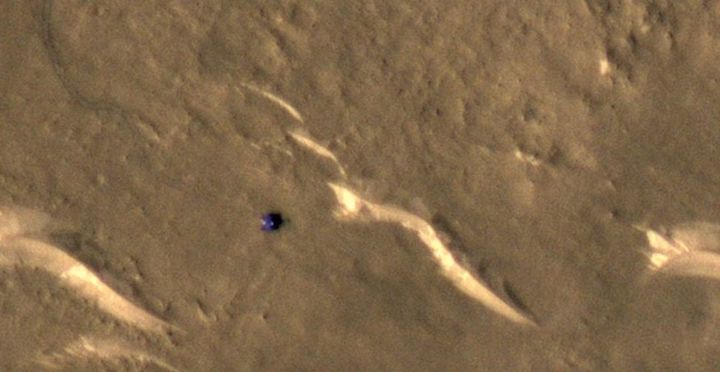
The HiRISE camera aboard NASA's Mars Reconnaissance Orbiter captured this image of China's Zhurong rover on the Martian surface on March 11, 2022. (Image credit: NASA/JPL-Caltech/UArizona)
A NASA spacecraft orbiting Mars has spotted China's Zhurong rover down on the surface, providing an epic overview of the vehicle's travels through the red dirt.
The Mars Reconnaissance Orbiter (MRO) captured the image of Zhurong on March 11, according to a post from the researchers behind MRO's powerful HiRISE (High Resolution Imaging Science Experiment) camera.
Despite MRO orbiting 179 miles (288 kilometers) above, HiRISE managed to pick up the roughly 0.93 miles (1.5 km) of tracks that Zhurong has made journeying south since landing in May 2021, a cutout image with increased contrast shows.
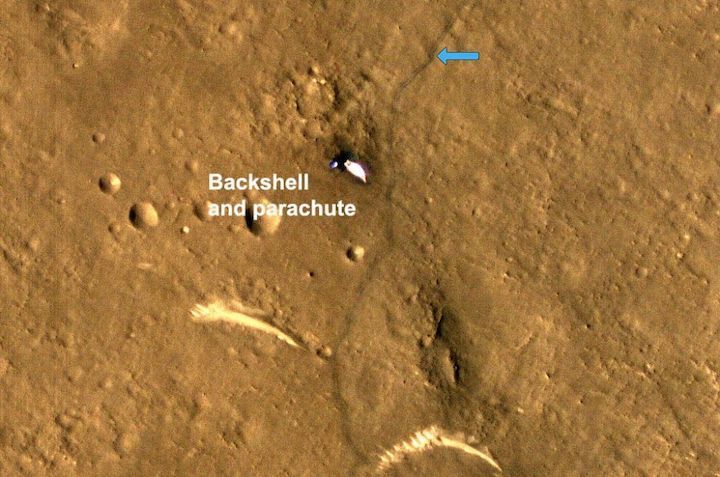
This zoomed-in section of HiRISE's imagery of China's Mars rover Zhurong and its tracks, captured on March 11, 2022, shows that the rover inspected the backshell and parachute that helped it land safely in May 2021. (Image credit: NASA/JPL-Caltech/UArizona)
The photo shows that the rover visited the parachute and backshell that slowed Zhurong's descent through the thin Martian atmosphere while also surveying surface features, including dunes.
Zhurong is part of China's Tianwen 1 mission, which also includes an orbiter. Last month, that orbiter marked a full (Earth) year of circling the Red Planet. (Zhurong stayed attached to the orbiter for several months before separating for its May 2021 touchdown.)
Quelle: SC
+++
China releases images of Martian dust taken by Tianwen-1 orbiter
China's Tianwen-1 orbiter has beamed back high-resolution images of Mars, showing dust storms on the surface of the planet.
Released by the China National Space Administration on Thursday, the new pictures with a resolution of 0.5 meters were captured by a camera on the probe, which has been operating in orbit for 609 days at a distance of 277 million km from Earth.
Track marks left by Mars rover Zhurong can be seen in the pictures. With its 306 Martian days of service, the rover has traveled a total of 1,784 meters on the planet.
Zhurong also snapped selfies from Mars. Compared with the images taken shortly after it landed on the planet, the new photos showed a layer of dust accumulated on its surface.
Dust can reduce rovers' power supply. Chinese scientists have specially designed the rover's solar wing to offset the efficiency decline caused by dust coverage.
The rover now has sufficient energy to continue its exploration on Mars, the Chinese space administration said in a statement.
The Tianwen-1 orbiter has monitored dust activities in the northern hemisphere of Mars since late January and sent back pictures of regional dust storms in February. No obvious dusty weather has been observed in the Zhurong rover's inspection area, according to the administration.
Quelle: Xinhua
+++
A rare update from China on the Tianwen-1 mission, with a nice comparison of Zhurong images from Sol 5 (May 2021) and Sol 247 (Jan. 22), showing the accumulation of dust on the rover body and solar panels [CNSA/PEC]
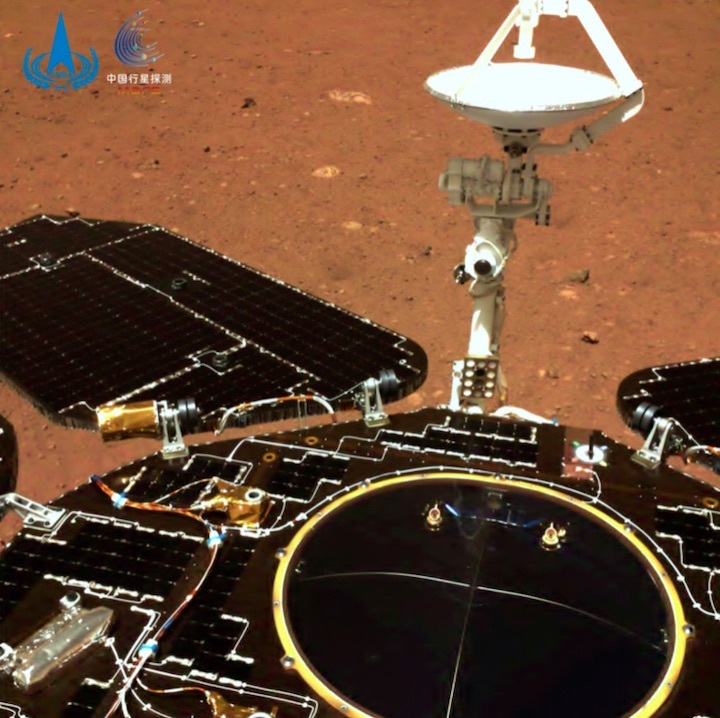
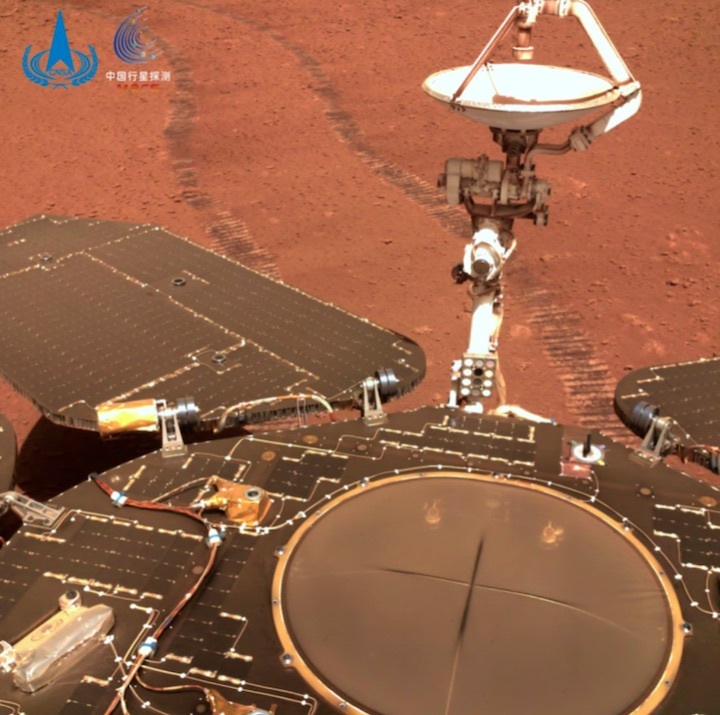
Quelle: CNSA
----
Update: 4.05.2022
.
China's Zhurong travels over 1.9 km on Mars
The Mars rover Zhurong has traveled more than 1.9 km since it first set its wheels on the surface of the planet in May last year, according to the latest data released by the Lunar Exploration and Space Program Center of the China National Space Administration.
As of Sunday, Zhurong had been operating on the surface of Mars for 342 Martian days at a distance of 240 million km from Earth. A Martian day is approximately 40 minutes longer than a day on Earth.
Zhurong touched down on the Utopia Planitia, a vast plain in the northern hemisphere of Mars, on May 15, 2021. Since then, it has collected surface rock samples and captured images while exploring the planet.
Mars is about to enter the winter season, during which night temperatures will drop below minus 100 degrees Celsius, with a high probability of sandstorms. Martian winters last an equivalent of six Earth months.
Scientists have made special designs on the Zhurong rover, including low temperature resistance, sand resistance, power security and other features, to ensure the safe conduct of the Mars patrol and exploration process.
The Chinese space administration also disclosed that lunar rover Yutu-2, or Jade Rabbit-2, has been working for 42 lunar days and moved 1,181 meters on the moon surface.
China's Chang'e-4 probe, including a lander and Yutu-2 launched on Dec. 8, 2018, made the first-ever soft landing on the Von Karman Crater in the South Pole-Aitken Basin on the far side of the moon on Jan. 3, 2019.
Quelle: Xinhua
----
Update: 13.05.2022
.
China's Mars rover finds water evidence on the red planet: study
Chinese scientists have found new evidence that there was water on Mars in the past and there are hydrated minerals on the red planet, which can be potentially exploited during future crewed Mars missions.
The study published on Thursday in the journal Science Advances revealed that a large impact basin on Mars contained liquid water during the Amazonian epoch, the planet's most recent geologic epoch.
The findings contribute to a growing body of telltale signs that suggests liquid water activities may have persisted much longer on Mars than previously thought.
The study also indicated that in this particular site, there are currently considerable stores of water in the form of hydrated minerals and possibly ground ice.
The researchers led by those from the National Space Science Center under the Chinese Academy of Sciences used data gathered by China's Mars rover Zhurong on the sedimentary and mineral characteristics of southern Utopia Planitia, a vast plain in the northern hemisphere of Mars.
They interpreted the bright-toned rocks Zhurong's camera caught as a layer of "duricrust" that would have been sculpted by a substantial quantity of liquid water, perhaps rising groundwater or melting subsurface ice.
That solid sulfate mineral crust contrasts with thinner, weaker duricrusts observed by other Mars rovers, which may have formed through the actions of water vapor, according to the study.
Another Chinese study published in March in the journal Nature Geoscience also revealed that the site where Zhurong landed might have experienced wind and possibly water erosion.
Quelle: Xinhua
----
Update: 16.05.2022
.
China Focus: Tianwen-1 mission marks first year on Mars
It has been a year since China's Tianwen-1 probe reached Mars. The mission has not only marked an important step in the country's interplanetary exploration but has also made a number of achievements in that time.
The Tianwen-1 probe consists of an orbiter, a lander and a rover. On May 15, 2021, it touched down at its pre-selected landing area in Utopia Planitia, a vast Martian plain, marking the first time that China has landed a probe on the planet.
A week later on May 22, 2021, the Mars rover Zhurong, which resembles a butterfly, drove down from its landing platform to the Martian surface. On June 11, the China National Space Administration released the first photographs taken by Zhurong, signifying a complete success in the country's first Mars exploration mission.
FRUITFUL RESULTS
Since landing, Zhurong has continued moving southward and transmitted data back to Earth. It has completed explorations of the Martian surface, passed through multiple complex terrains, and detected Martian rocks, sand dunes and impact craters, obtaining a large amount of data using its onboard scientific equipment.
By Aug. 15, 2021, Zhurong had worked on the planet's surface for 90 Martian days, or about 92 days on Earth, accomplishing all exploration and detection tasks as planned. It was in good condition and continued service despite reaching its planned working target of 90 days.
From mid-September to late October last year, the Mars orbiter and Zhurong suspended their explorations and relied on their own autonomous systems to survive their first solar outage, during which time solar electromagnetic radiation increased and disrupted communication between the probe and Earth.
In November 2021, Zhurong and the European Space Agency's Mars Express spacecraft performed an in-orbit relay communication test.
In May this year, using data gathered by Zhurong on the landing site, Chinese scientists found new evidence suggesting the presence of liquid water activity and hydrated minerals on the red planet.
By May 5, 2022, the Tianwen-1 orbiter had been operating for 651 days at a distance of 240 million kilometers from Earth. Zhurong had been working for 347 Martian days and traveled 1,921 meters. The orbiter and rover, operating normally, had obtained approximately 940 gigabytes of data.
FUTURE ENDEAVORS
The Tianwen-1 mission is only the beginning of China's planetary exploration, and many new endeavors are in the pipeline.
According to a white paper titled "China's Space Program: A 2021 Perspective," the country will continue its lunar exploration with the future Chang'e-6, Chang'e-7 and Chang'e-8 missions. It will complete the construction of an international lunar research station together with other countries, global organizations and partners.
Future plans also include launching an asteroid probe, retrieving samples from near-Earth asteroids, and retrieving samples from Mars.
The Tianwen-2 probe has entered the preliminary prototype development stage.
Quelle: Xinhua ---- Update: 20.05.2022 .
China's Zhurong rover switches to dormant mode in severe Martian dust storm
Mars rover Zhurong has been switched to dormant mode while waiting out a dust storm on the surface of the planet, the China National Space Administration said on Friday.
The latest images taken by cameras onboard China's Tianwen-1 Mars orbiter show a dust storm passing over the patrol area of Zhurong. Scientists compared them with photos taken in the last two months and analyzed recent power data of the rover's solar wings, which indicated Zhurong now braving an intense Martian dust storm.
According to the administration, the patrol area of Zhurong has entered the winter season, during which the daytime temperatures can drop below minus 20 degrees Celsius, while the night below minus 100 degrees Celsius. By mid-July, the temperatures will fall further.
To tackle the dust storms and low-temperature challenges, the Chinese rover went into dormancy on Wednesday. It is expected to wake up and resume work in December when the dust clears and Mars enters its spring season, the administration said in a statement.
Scientists will continue to use the Tianwen-1 orbiter to monitor the weather on Mars' southern hemisphere. Quelle: Xinhua
----
Update: 1.07.2022
.
China Focus: China's Mars probe completes targeted exploration
The orbiter and rover of China's Tianwen-1 probe have both completed the targeted scientific exploration missions, announced the China National Space Administration (CNSA) on Wednesday.
As of Wednesday, the orbiter of Tianwen-1 has been operating normally for 706 days. It has acquired the medium-resolution image data covering the whole globe of Mars, with all of its scientific payloads realizing global survey, said the CNSA.
By now, the orbiter has circled Mars 1,344 times. For future missions, it will continue to conduct the whole-globe remote sensing survey and expand tech experiments, said the CNSA.
The Tianwen-1 probe consists of an orbiter, a lander and a rover Zhurong. On May 15, 2021, it touched down at its pre-selected landing area in Utopia Planitia, a vast Martian plain, marking the first time that China has landed a probe on the planet.
The rover Zhurong started patrolling Mars on May 22, 2021.
As of Aug. 15, 2021, Zhurong had finished the designed 90-Martian-day mission and continued to work for further exploration.
Having traveled around 1,921.5 meters on the surface of Mars, Zhurong, on May 18 this year, switched to the dormant mode due to the chilly winter and dusty weather on the red planet. It will resume operation around this December when the working conditions are getting better.
After two years of flight and exploration, the rover and orbiter have acquired 1,040 gigabytes of raw scientific data with their 13 onboard scientific payloads.
Being received and processed on Earth, the data will be formed into standard scientific data products. They will then be delivered to scientists for further analysis and interpreted monthly. Related results have been published in renowned journals at home and abroad.
These scientific data will be opened to scientists worldwide. China welcomes global scientists to apply for related research and jointly push forward the exploration of the universe, said the administration.
In line with the spirit of openness and sharing, the CNSA will actively push forward cooperation with all countries' space agencies and scientific communities, the administration added.
The CNSA has shared with NASA and the European Space Agency (ESA) the data of the Mars orbiters and cooperated with them in collision forecast.
Zhurong and the ESA's Mars Express spacecraft performed an in-orbit relay communication test.
Around the transit of Mars, the CNSA carried out the observation of solar occultation and solar wind together with observatories in Russia, Germany, Italy, Australia, South Africa and other countries, by using orbiters of the Tianwen-1 probe and the Mars Express.
All these global cooperations have achieved great fruits, enriched the knowledge of humankind, and contributed to the building of a community with a shared future for mankind in the domain of science, said the CNSA.
Quelle: Xinhua
----
Update: 7.07.2022
.
Wheels on China's Zhurong rover keep stable with novel material
New material has been maintaining high stability of the rover Zhurong on China's Tianwen-1 probe, according to the Institute of Metal Research of the Chinese Academy of Sciences.
The researchers from the institute developed the wheels on the rover. The novel material of the wheels is an aluminum matrix silicon carbide composite. Its plasticity was enhanced apparently, with high strength, resistance and stability.
The reliability of the novel material was proved by the complex conditions on the surface of Mars, said Ma Zongyi, a researcher with the institute.
The researchers have also developed more than 50 types of components such as driving systems and detectors for Zhurong.
As of June 29, the orbiter of the Tianwen-1 probe has been operating normally for 706 days. It has acquired medium-resolution image data covering the whole globe of Mars, according to the China National Space Administration.
The Tianwen-1 probe consists of an orbiter, a lander, and the rover Zhurong. On May 15, 2021, it touched down at its pre-selected landing area in Utopia Planitia, a vast Martian plain, marking the first time that China has landed a probe on the planet.
The rover Zhurong started patrolling Mars on May 22, 2021. As of Aug. 15, 2021, Zhurong had finished the designed 90-Martian-day mission and continued to work for further exploration.
Having traveled around 1,921.5 meters on the surface of Mars, on May 18, 2022, Zhurong switched to the dormant mode due to the chilly winter and dusty weather on the red planet. It will resume operations around this December when the working conditions get better.
Quelle: Xinhua
----
Update: 27.07.2022
.
China's Mars orbiter snaps striking shot of Red Planet's larger moon, Phobos
The image of the larger Martian moon marks the mission's second launch anniversary.
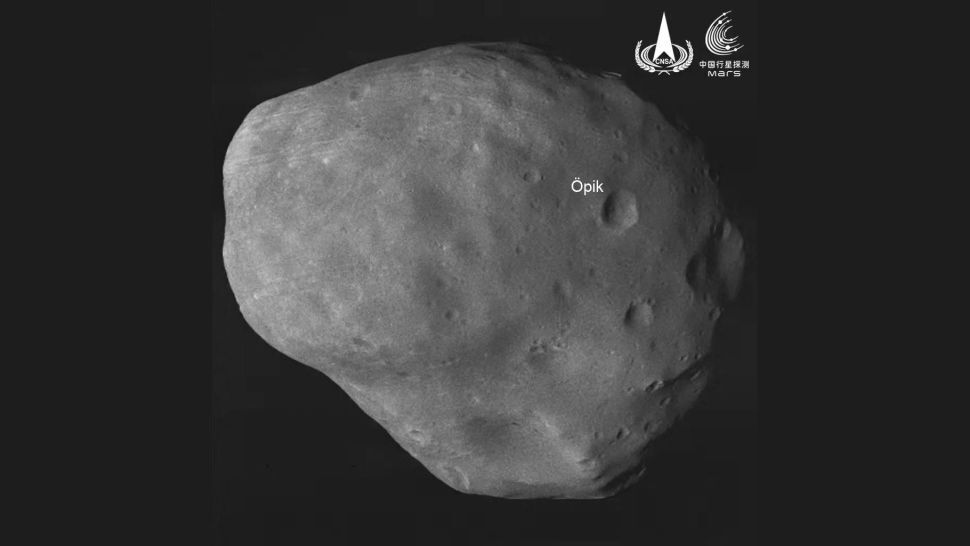
Phobos, the largest of two natural satellites of Mars, as imaged by the Tianwen 1 orbiter. (Image credit: CNSA/PEC)
China's Tianwen 1 Mars orbiter has returned a stunning image of the Martian moon Phobos to mark the second anniversary of the mission's launch.
Tianwen 1 captured the photo with its high-resolution camera, the same instrument used to image the landing area for the mission's Zhurong rover. At the time, the Marsorbiter was 3,200 miles (5,100 kilometers) away from Phobos, which is the larger of the Red Planet's two moons
Tianwen 1 needed to alter its attitude — or orientation — to image Phobos, while also needing to select a precise moment during their respective orbits around Mars that would provide a relatively close approach and good lighting conditions from the sun.
The image provides a resolution of 160 feet (50 meters) per pixel, with some of Phobos's distinct linear grooves visible on the surface.
The image, released by the China National Space Administration (CNSA) and the Planetary Exploration of China (PEC) also notes Öpik Crater. The feature was named for Estonian astronomer and astrophysicist Ernst Öpik, who postulated the theory of a cloud of comets and icy objects way beyond Pluto, now known as the Öpik-Oort cloud.
Tianwen 1 launched on July 23, 2020, and recently completed its primary science goals, including mapping the entire surface of Mars. It has returned a range of impressive images, including "selfies" taken by small, disposable spacecraft deployed for the purpose.
The orbiter journeyed to Mars along with the Zhurong rover, which landed in Utopia Planitia in May 2021. The solar-powered rover is currently hibernating, as it is winter in the northern hemisphere of Mars.
Quelle: SC
----
Update: 20.09.2022
.
China's first Mars exploration mission achieves rich scientific results
China's first Mars exploration mission has achieved rich scientific results, the China National Space Administration (CNSA) said Sunday.
As of Thursday, the Tianwen-1 orbiter has been operating normally for over 780 days, and the rover Zhurong has traveled 1,921 meters on the surface of Mars, the CNSA said.
The orbiter and rover of China's Tianwen-1 probe have completed the targeted scientific exploration missions and have acquired 1,480 gigabytes of raw scientific data.
The Tianwen-1 probe consists of an orbiter, a lander, and a rover. On May 15, 2021, it touched down at its pre-selected landing area in Utopia Planitia, a vast Martian plain, marking the first time China has landed a probe on the planet.
Quelle: Xinhua
----
Update: 21.09.2022
.
China's Mars rover expected to resume work in December
China's Mars rover Zhurong, currently in sleep mode, is expected to wake up automatically in December when its energy level hits over 140 watts and the temperature of components like the battery rise above minus 15 degrees Celsius, according to its research team.
Jia Yang, deputy chief designer of the Tianwen-1 Mars mission from the China Academy of Space Technology, said Zhurong will resume work once it has met these two specific conditions. He revealed the news at a science popularization event held in Beijing on Monday night.
After waking up, the Chinese rover will continue to head south to acquire more data on the planet, Jia added.
On May 18 this year, having traveled around 1,921.5 meters on the surface of Mars, Zhurong switched to dormant mode due to the chilly winter and dusty weather on the planet.
Quelle: Xinhua

